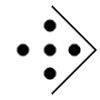
The Ancient Egyptians had many board games, but Senet was the most popular. It was played by wealthy and poor people alike, and boards have been found in many different places. Egyptian peasants could play it with boards drawn in the sand and stones or small ceramic playing pieces. Pharoahs, including Tutankhamon, owned fancy sets made from wood, ivory, and faience. Senet boards were also carved into temples and tombs. There are many Egyptian tombs with paintings of people playing Senet, and there are religious writings that describe games of Senet that take place in the afterlife. The game itself may have religious significance, representing a soul's journey through the underworld (Grunfeld 53). Senet may be a distant ancestor of Backgammon (Parlett 68).
There are companies that make replicas of ancient Senet boards, like the replica in this picture (click on it to see it larger). A version of Senet also appears in one of the Nancy Drew computer games by Her Interactive, Tomb of the Lost Queen, and there is an inexpensive version of the game available through Steam.
Senet
The original rules of Senet are uncertain because the surviving descriptions of the game do not explain exactly how to play. However, some scholars have attempted to recreate the rules. Gustave Jequier, a Swiss archaeologist, compiled the following rules based on the sources available. Edgar B. Pusch, a German Egyptologist, confirmed the basic points of this game with his own research (Grunfeld 53). The rules given here are Jequier's as described in Grunfeld's Games of the World, p. 54, with further explanation from Parlett's The Oxford History of Board Games, pp. 66-68.
Players: 2
Object: To be the first to reach the end of the path and remove all of your pieces from the board.
Equipment: Senet board (printable), two sets of 5 playing pieces (each set should be a different color and shape so they can be easily distinguished from each other, I used circles and squares cut from colored paper), four dice sticks (It is important for these to be flat, two-sided sticks (some sets have one side rounded and the other flat) with a different color on each side, typically black and white. I made my own from popsicle sticks, painted black on one side and white on the other. You can also use permanent marker to color the sides.)
Set Up: Senet is a race game. A Senet board is made up of 30 squares, arranged in a 3x10 rectangle. (Five of them are marked off as special spaces, and they may appear differently on different boards. I'll explain them later.) There are two sets of 5 pieces, one for each player. (According to Parlett (p. 67), there are earlier versions with 7 pieces on a side, but here we'll just use 5.) One set of pieces is dark and the other is light. They can also be different shapes as well as different colors (Parlett 67). The two sets of pieces are arranged on the first row of the board in an alternating pattern, like this:

Moving: Movement on the board follows a kind of switchback path. To help explain it, I've added arrows and numbered the spaces to show their order. Spaces 1 through 10 are where the pieces start at the beginning of the game.

The Dice Sticks: Players use four two-sided dice to determine the number of spaces their pieces can move. These "dice" look like short, flat sticks, colored white on one side and black on the other. The players toss the four dice onto the table at the same time and determine the number of spaces they should move by the colors of the sides facing up.

- One white side and three black = 1
- Two white sides and two black = 2
- Three white sides and one black = 3
- All four white sides = 4
- All four black sides = 6
At the beginning of the game, the players take turns throwing the dice until someone gets a 1. This person is the first player and gets control of the dark pieces. The first player's first move must be to take the dark piece on square 10 and put it on square 11. This frees up the rest of his pieces to move. The first player tosses the dice again. Depending on the value of his toss, there are two things that can happen:
- If the value = 1, 4, or 6:
- The player moves one of his pieces (any piece he chooses) the number of spaces shown on the dice. Then, he tosses the dice again and follows the directions under that value. Rolls of 1, 4, or 6 always allow him to roll again no matter how many times he's already rolled.
- If the value = 2 or 3:
- The player moves a piece (any piece) the number of spaces shown on the dice. Then, the player's turn ends, and his opponent takes his turn. Every turn ends when someone gets a 2 or 3.
When the first player's first turn is over, the second player's first move must be to move the light piece on square 9 (no matter what value he gets on the dice). After that, he can move any of his pieces, following the directions for the listed values with each roll of the dice. Players cannot have more than one of their own pieces on the same space at the same time, although their pieces may pass over each other while moving.
Attacking: As the players move down the path, there are ways that they sabotage each other's progress. If a player lands on a square already occupied by one of his opponent's pieces, he "attacks" that piece, sending it back down the path to the square that the attacking piece just came from. However, if there are two pieces friendly pieces sitting on consecutive squares (ex. squares 14 and 15), neither of those pieces can be attacked, with the idea that friends would protect one another. An enemy piece may move past two friendly pieces standing side-by-side, but it cannot land on either of them.
Blocking: If someone manages to get three of their pieces in a row, those pieces are not only immune from attack, but they completely block enemy pieces from passing them as long as they stay in place. Friendly pieces can continue to pass through a blockade.
If someone cannot move any of his pieces forward with the number on the dice because the pieces are blocked, that person must move one of his pieces backward along the path that number of spaces. However, that player still cannot move backward to an occupied square (no matter which side occupies it), so if there are no free spaces for any of his pieces to go, even backwards, the player must forfeit his turn completely.
Special Spaces: You'll notice that there are a few spaces on the board with special symbols. The space with the "X" on it (square 27) is a trap. If someone lands on this space, his piece has to go all the way back to the beginning, square 1. If square 1 is already occupied, the piece has to go to the open space that is the closest to square 1. From there, it continues down the path normally. All the other special spaces are safe spots. Pieces on those spaces are safe from attack.
Winning the Game: The winner is the one who removes all of his pieces from the board first. To remove them from the board, he must first get all five of his pieces onto the last row of the board (squares 21 through square 30, also called the exit row). From there, he must get the pieces, one by one, to square 30. The player must get the exact amount of the move on the dice in order for a piece to land on square 30 (ex. A roll of 5 wouldn't work if the piece had only 4 more spaces to move.). Once a piece lands on square 30, it can be removed from the board. If any of the player's pieces in the exit row are moved back to the earlier rows because of attack or landing on the trap space, the player must move them back into the exit row before continuing to remove pieces from the board.
Optional Scoring: Although the first player to remove all of his pieces from the board wins, if you play a series of games, you could add an extra scoring system. At the end of each game, the winning player receives points for each of the following:
- One point for each enemy piece in the exit row but not on the safe spots.
- Two points for each enemy piece in the second row.
- Three points for each enemy piece in the first row.

